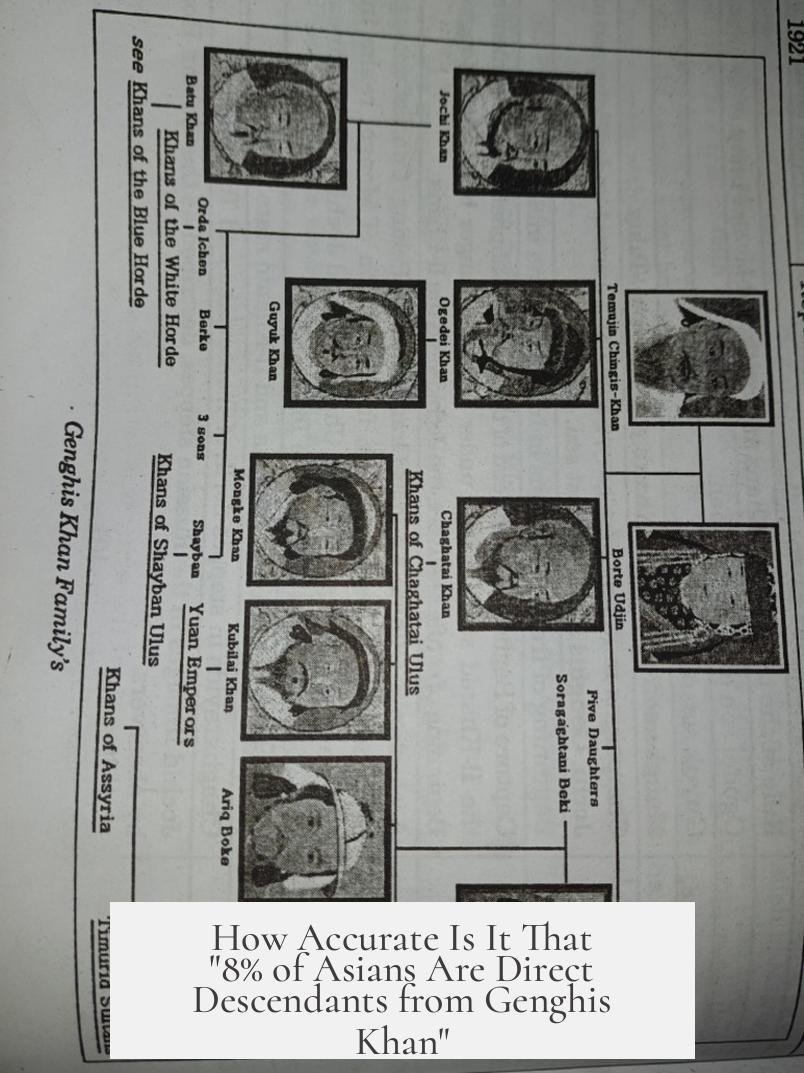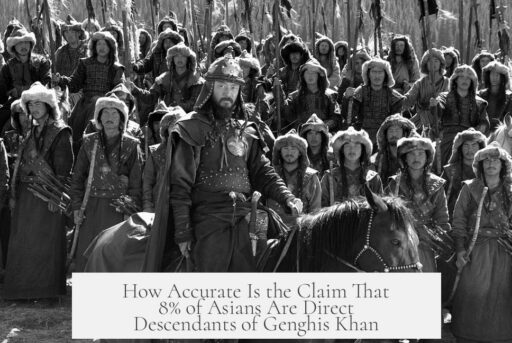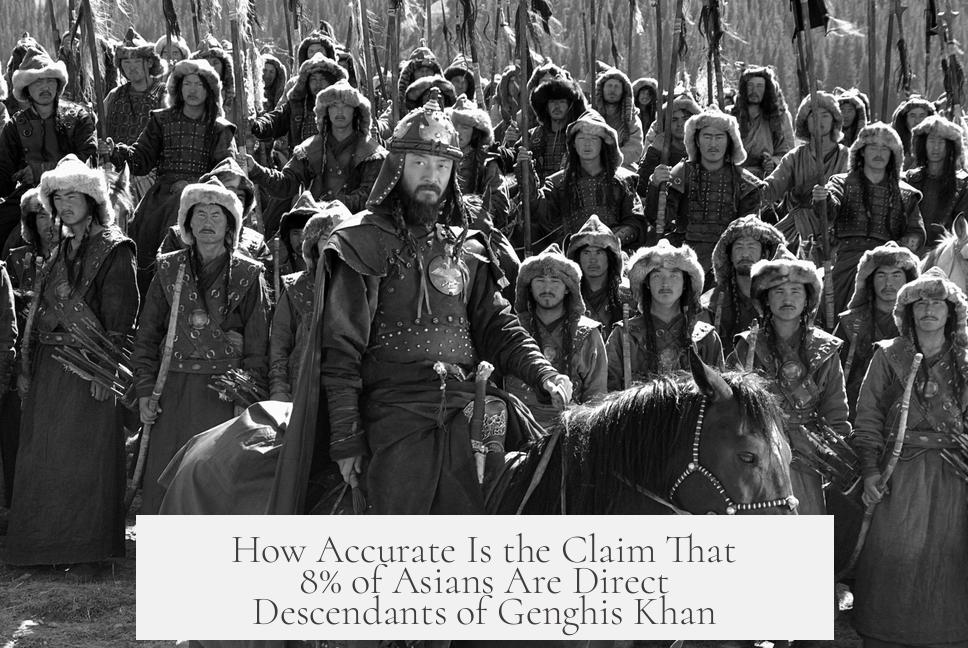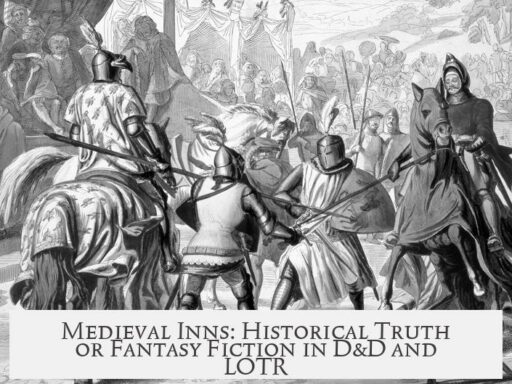The claim that “8% of Asians are direct descendants from Genghis Khan” specifically refers to direct male-line descendants, meaning individuals who inherit their Y chromosome from Genghis Khan without interruption through their paternal lineage. This figure does not represent all descendants but targets those carrying his Y chromosome pattern. It is based on genetic studies identifying a widespread Y chromosome lineage believed to have originated from Genghis Khan or his close male relatives.
Understanding this claim requires clarity on what “direct descendants” and “direct male-line descendants” mean. Direct male-line descent traces the paternal lineage from father to son through many generations, preserving the Y chromosome. This lineage is traceable and genetically identifiable. In contrast, “direct descendants” broadly includes anyone descended from an ancestor through any combination of male and female lines. Over many centuries, the latter group tends to include a large portion of a population simply due to the mathematics of genealogy.
The approximate 8% figure is derived from studies of the Y chromosome in Asian males. It is found that about 8% of men from a large region of Asia carry this particular Y chromosome type, which has very low genetic diversity and a high frequency, suggesting a common origin around 1,000 years ago. Researchers associate this with Genghis Khan, due to historical context and the rapid expansion of his lineage during and after his reign.
However, this statistic sometimes leads to misunderstandings. It does not mean 8% of all Asian men are descendants of Genghis Khan in any form, but specifically those who have inherited his Y chromosome without breaks in that paternal line. It excludes descendants through female lines or non-paternal ancestors.
Genealogy mathematical models help contextualize this further. Genghis Khan died in 1227, roughly 30–34 generations ago, assuming a generation length of about 25 years. Each generation doubles the number of ancestors, so theoretically, a person today could have over a billion ancestors at that depth. However, this number exceeds historical global population size, meaning many ancestors must repeat in family trees due to pedigree collapse—ancestors appearing multiple times in a lineage.
This mathematical fact means that most people living in Asia today are related to Genghis Khan, either through male or female lines. His descendants have proliferated over centuries, but the particular spread of his Y chromosome in about 8% of Asian men marks a genetic legacy distinct from general distant ancestry.
Mathematically, this is often explained with binary tree growth models. If each male descendant had only two children per generation, the count of descendants grows exponentially:
- 1 generation: 2 descendants
- 3 generations: 8 descendants
- 34 generations: Over 34 billion hypothetical descendants (far more than the current human population)
This shows an absurd overcount, proving that many descendants overlap, and nearly every person in Asia has some descent from Genghis Khan. The oversimplified model underscores why the 8% only pertains to direct male-line descendants with his Y chromosome.
The 8% figure specifically reflects genetic studies published around 2003 identifying a Y chromosome lineage prevalent in 16 populations across Asia, comprising about 0.5% of the world’s male population at that time. The study linked this haplotype to a common ancestor who lived around a millennium ago, fitting the timeline of Genghis Khan. It is often stated as “eight percent of men in a large region of Asia,” not all Asians indiscriminately.
This genetic evidence is unique because the Y chromosome lineage is unusually common compared to any other from the same period. Such a finding supports historical accounts about Genghis Khan’s reproductive success and the resulting demographic impact.
In contrast, claims like “everyone in Europe descends from Charlemagne” arise from similar genealogical mathematics. Over many generations, nearly everyone with European ancestry can trace some lineage back to historical figures from a millennium ago. But identifying direct paternal or maternal genetic lines is more precise and less diluted across generations.
The key points to recognize are:
- The 8% figure refers to direct male-line descendants carrying Genghis Khan’s Y chromosome, not all descendants.
- Mathematical models of ancestry show that most people in Asia likely descend distantly from him, but fewer than 8% carry his Y chromosome.
- Y chromosome inheritance allows tracking of paternal lineage specifically and is stable enough to identify such ancestry over centuries.
- The 8% figure comes from genetic research, not just historical extrapolation or hearsay.
- Different interpretations of “descendant” cause confusion about the significance of this number.
Key Takeaways:
- The “8%” refers to direct male-line descendants, identified by shared Y chromosomes linked to Genghis Khan.
- It does not mean 8% of all Asians are descendants, but a subset with paternal lineage intact.
- Mathematical genealogy shows nearly everyone in Asia potentially descends from him, through various lines.
- Genetic studies support this claim based on prevalence and mutation rates of a particular Y chromosome lineage.
- Understanding the difference between direct male-line descent and general descent is crucial.
How Accurate Is It That “8% of Asians Are Direct Descendants from Genghis Khan”?

Let’s get straight to it: The claim that 8% of Asians are direct descendants from Genghis Khan holds a very specific meaning. It refers only to direct male-line descendants, not all descendants. In other words, these are people whose father, grandfather, great-grandfather, and so on, straight back to Genghis, passed down the same Y chromosome passed down only through the male line.
This distinction is crucial because it limits the scope of the claim. The 8% figure comes from a groundbreaking genetic study measuring Y chromosome markers that match those believed to have belonged to Genghis Khan. This genetic fingerprint appears vastly more often in parts of Asia than any other Y chromosome from that era. The reason? This Y lineage spread widely and rapidly after his reign.
Direct Male-Line versus Direct Descendants – Why It Matters
When people casually hear “descendants,” they often imagine anyone related to Genghis Khan in any way—sons, daughters, grandchildren, cousins… everyone. But that’s not what this 8% means. It’s all about direct male-line descendants. This is a much narrower definition because this Y chromosome is inherited only from father to son, untouched by females.
As generations pass, everyone’s broader tree of ancestors grows exponentially, but that’s not true for Y chromosome lines. It only passes down from father to son. So, while almost everyone alive today may be related to Genghis Khan in some distant way, only about 8% of Asian men carry his exact Y chromosome line.
Crunching the Numbers: The Math Is Surprisingly Wild
Genghis Khan died around 1227, nearly 800 years ago. Assuming roughly 25 years per generation, that’s about 34 generations ago. If you follow the math of ancestry as a perfect binary tree, each generation doubles your ancestors: 2 parents, 4 grandparents, 8 great-grandparents, and so on.
In 34 generations, that number balloons to over a one billion distinct ancestors. But wait, the world’s population back then was less than half a billion! How’s that possible?
This paradox happens because family trees overlap; ancestors occupy multiple branches in your tree, meaning many ancestors appear more than once. Therefore, statistically, this overlap suggests that it’s very likely most Asians today share ancestry with Genghis Khan—if you look beyond just the male line.
The 8% Figure: Fact or Fiction?

Here’s where things get intriguing. The 8% statistic refers to people with Genghis Khan’s exact Y chromosome, but where does that number come from exactly? Some genetic studies have found a Y chromosome lineage believed to trace back to Genghis Khan in about 8% of men in the region stretching from Mongolia to northern China.
However, skepticism is wise here. The 8% is an estimate based on sampling and assumptions about mutation rates and history. It’s a simplified headline that’s easy to misinterpret. The common misconception is to think Genghis Khan had an enormous number of children whose descendants make up 8% of Asia. The truth is, the genetic spread involves a complex mix of population dynamics, lineage survival, and historical conquests.
Why This Claim Captures Our Imagination
Think about it: the idea that one man from 800 years ago could be a direct male ancestor to nearly 1 in 12 Asian men is somewhat mind-boggling. It sounds like the stuff of legend, but science backs up at least this basic idea—though in a very specific genetic sense.
It helps highlight how historically powerful men could leverage their status in polygamous societies, spreading their genetic line far more than the average person. But in the same breath, it reminds us that with enough time, everyone’s related to many famous historical figures—whether it’s Charlemagne in Europe or Alexander the Great.
So, Are Most Asians Descended from Genghis Khan, or Is It Just a Genetic Lottery?
Both answers hold some truth. Most Asians are indeed likely to have Genghis Khan somewhere in their family tree if you stretch definitions broadly, but only a smaller fraction—around 8%—inherit his direct Y chromosome line.
This opens a window into how ancestry works over centuries: genetic lines overlap, diverge, and sometimes disappear. Claims citing neat percentages often simplify a very tangled web.
Lessons and Takeaways
- Terminology matters: Understand the difference between direct male-line descendants and general descendants.
- Data interpretation: Genetic data are estimates and should be treated cautiously.
- Mathematical perspective: Genealogy over many generations becomes complex quickly, making some sweeping claims imprecise.
- Historical context: Genghis Khan’s conquests and polygamy explain how his genetic line could spread so widely.
In conclusion, the headline **”8% of Asians are direct descendants from Genghis Khan”** is accurate—but with a specific meaning and important caveats. It’s a fun fact that captures imagination, but let’s keep the math and genetics in our pocket when repeating it next time.




